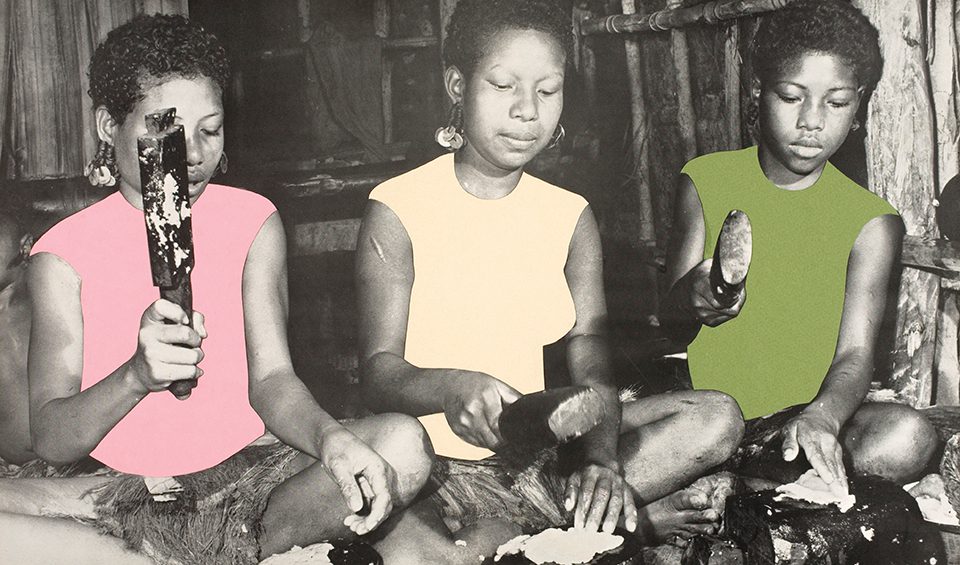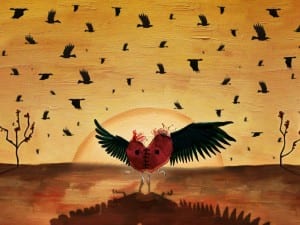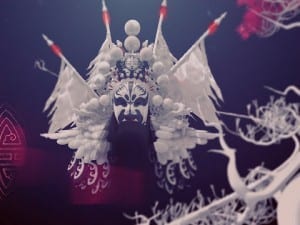Shigeyuki Kihara: Living Photographs was on at The Metropolitan Museum of Modern Art in New York City 2008. This insightful exhibition explores themes of Pacific culture, identity, colonialism, stereotypes and gender roles.
Preconceived notions are the food for artistic expression. Such notions deconstructed have a strong history of propelling society forward. Samoan visual and performance artist, Shigeyuki Kihara, who has lived in Japan, Indonesia, and now New Zealand, but was raised primarily in Samoa, feasts on challenging traditional understandings of the Pacific Islander through her art.
Born of a Japanese father and Samoan mother, Kihara reveals to Aesthetica, “I knew that I had an eye for appreciating beauty in every situation ever since I entered the world of the living in 1975.” Her innate calling to express through art, however, was discouraged by her parents as not being a true profession. Consequently, she ended up enrolling in fashion design school at Wellington Polytechnic (now Massey University) in New Zealand from 1993 until 1996. “It was from working as a fashion stylist that I became more interested in studio photography and art directing. As a result, I ended up using it in my own art practice.”
Her art has travelled both conceptual and oceanic distances. Marked as the first presentation of Samoan contemporary art at The Metropolitan Museum of Art in New York City, Shigeyuki Kihara: Living Photographs, which continues until 1 February 2009, explores themes of Pacific culture, identity, colonialism, indigenous spirituality, stereotypes, gender roles, and consumerism.
Exhibiting at The Metropolitan Museum of Art could be considered the tour de force in an artist’s life, and for such an event to occur while involuntary respiration still occurs, pays further tribute to the power of Kihara’s body of work. Other behemoth institutions such as Sydney’s Museum of Contemporary Art and the UK’s University Museum of Archaeology and Anthropology in Cambridge further strengthen the breadth of influence Kihara continues to imprint upon the art world. “It’s a great compliment,” Kihara shares, “however those are not the only the venues I showcase my work, as I also exhibit and do projects at community art centers and galleries that are known to be political.”
The Shigeyuki Kihara: Living Photographs exhibit illuminates outsider perceptions to specific moments in the life, history, art and traditions of Samoan society. The pieces were selected from four series of Kihara’s recent work. Her signature series entitled Fa’a Fafine: In a Manner of a Woman (2004-5) powerfully addresses cultural and gender assumptions through performance and photography. The term Fa’a Fafine refers to a third gender, specific to Samoan culture. Fa’a Fafine are biologically men who in childhood choose to be raised to assume female gender roles, which is not discouraged in the traditional Fa’asamoa (Samoan) society. Kihara says: “Making the series was personally challenging because the work raises issues and concerns that are personal to my experience as a Samoan Fa’a Fafine or a third gender person in today’s world. Being someone like me continues to have social, political and economic implications.”
For this series, the artist photographed herself as both a man and a woman in poses that mimic colonial images of Samoans. Haunting and beautiful, the images challenge Western frameworks and the binary — male or female — code of gender. “Samoan people are generally relaxed about issues surrounding gender, particularly to Fa’a Fafine persons,” says Kihara. However, there is less room in Western cultures for transgender persons. Many find themselves perched within the branches of queer society, where a more open attitude toward non-conforming sexuality is found, but nonetheless, it is still not a completely authentic place for third gender people. “There is a movement amongst the Fa’a Fafine within Samoa and the wider Samoan Diaspora to the USA, Australia and New Zealand,” Kihara states, “that has become independent of the Western queer movement because most of the time the Western queer movement is driven by, catered for, and to benefit white gay men.” The expression of this differentiation can be found in Kihara’s art and to the benefit of all transgender persons seeking a hook to hang their identity comfortably on, Samoan or not. And while the artist seeks to express the unique subtleties of her culture, she is appreciably after more.
“Unfortunately there are ignorant perceptions from the West,” Kihara states, “particularly with those who are documentary filmmakers, journalists and anthropologists who continue to misrepresent Fa’a Fafine purely through their fascination with the ‘primitive and exotic’ cultural sexual practices.” It is these misunderstandings that Kihara’s art redresses.
Taualuga: The Last Dance, a multimedia dance ritual performance inspired by Kihara’s interest in colonial photography from Samoa, complements the visual works in the Living Photographs exhibit. “When I used to look at colonial photographs,” Kihara notes, “I imagined how the Samoans in the photos would walk, talk and dance to me if they were alive today.”
Kihara’s art often arises out of the painstaking research that she undertakes. During a survey into colonial photography she became captivated by a photo of a Samoan woman dressed in a Victorian Mourning dress, which was in direct contrast to so many of the ‘soft porn’ portraits of Samoan people derived from the fictitious ideas of the Western photographers at the time. “The turbulent history of New Zealand Colonial Samoa at the time helped build a narrative around this Samoan woman where it became a 15-minute ritual performance staged in a theatre setting.”
The Met exhibit also includes works from the Black Sunday series (2001-2) where the artist uses collage and digital photography to comment on how Samoans were pictured in 19th-century colonial images. The series raises issues regarding authenticity and representation.
“By the time photography arrived in Samoa, Samoan people were already heavily indoctrinated into Christianity and as a result conformable with the idea of wearing clothes. However, when Samoan people went into the photographic studio, Western photographers asked people to take off their clothes and pose nude because it didn’t fit into the photographers’ fictitious idea of what a Samoan person looked like.” As such, the Black Sunday series features t-shirts and sunglasses on colonial portraits that were formally unclothed, to raise questions about control and authority, begging the question, “Who decides what is authentic?”
The 2004 Vavau series called Taema ma Tilafaiga: Goddess of Tatau, also featuring in The Met exhibition, depicts Samoan goddesses chanting about the art of tattooing. In the Fale Aitu: House of Spirits series (2003), the artist transformed herself into various guises, each a humanised manifestation celebrating aspects of the coconut tree, an essential plant in Samoan life. The Fale Aitu: House of Spirits works evoke a spooky, and beautiful sensuality so often found, but rarely articulated to perfection, in the deeper encounters with nature.
Kihara’s work successfully captures, synergizes, and transcends energies from many worlds, including those of the “primitive” and “exotic”, the Eastern and Western collective mind, the embodied and the out of body, and the prescribed understandings of male and female. Her art is at once a new testament that defies the established in ways unfamiliar to Westerners and has now been embraced by one of the world’s most prominent art institutions. It is easy to see why.
Shigeyuki Kihara: Living Photographs, curated by Virginia-Lee Webb continued until 1 February 2009, and is also featured on The Metropolitan Museum of Art’s website at: www.metmuseum.org.
Celeste Federico





